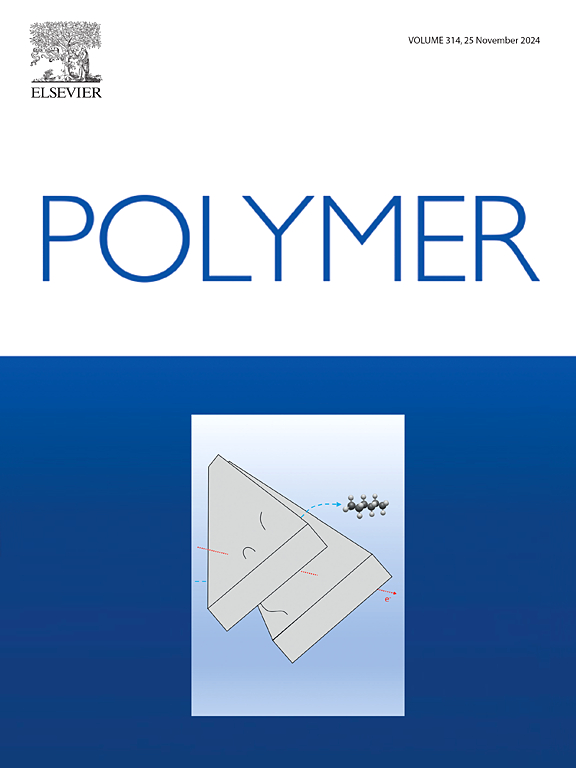The influence of reserved shish crystals on the structural evolution of ultra-high molecular weight polyethylene films with molecular weights in the tens of millions during the thermal stretching process
IF 4.1
2区 化学
Q2 POLYMER SCIENCE
引用次数: 0
Abstract
The molecular weight of polymers plays a critical role in determining the degree of chain entanglement, which in turn significantly constrains the structural evolution during thermal stretching. Therefore, understanding the influence of reserved shish crystals on the structural evolution of ultra-high molecular weight polyethylene (UHMWPE) films, particularly those with molecular weights in the range of tens of millions, is of paramount importance. In this study, UHMWPE films with molecular weights in the tens of millions were prepared by precisely controlling the molding temperature, allowing for the reserve of varying amounts of shish crystals. The structural evolution of these films during thermal stretching was systematically investigated using a combination of in-situ wide-angle X-ray diffraction (WAXD) and small-angle X-ray scattering (SAXS) techniques, complemented by ex-situ differential scanning calorimetry (DSC) and scanning electron microscopy (SEM) analyses. The results demonstrated that in this ultra-high molecular weight system, the reserved shish crystals exhibit greater lengths, leading to a significant reduction in the degree of chain entanglement. As the content of reserved shish crystals increased, the signal corresponding to tilted lamellae gradually diminished. Notably, in UHMWPE films with a high content of reserved shish crystals, no tilted lamellae signal was detected, and a higher proportion of shish-kebab crystals was generated by the end of the stretching process. These findings illustrate that the reserve of a greater number of shish crystals facilitates favorable structural evolution during the thermal stretching of UHMWPE films with extremely high molecular weights.


热拉伸过程中保留的shish晶体对分子量在千万级的超高分子量聚乙烯薄膜结构演变的影响
聚合物的分子量在决定链缠结程度方面起着至关重要的作用,而链缠结程度又在很大程度上限制了热拉伸过程中的结构演变。因此,了解保留的shish晶体对超高分子量聚乙烯(UHMWPE)薄膜结构演变的影响,特别是那些分子量在数千万之间的薄膜,是至关重要的。在这项研究中,通过精确控制成型温度,制备了分子量为数千万的超高分子量聚乙烯薄膜,允许保留不同数量的shish晶体。利用原位广角x射线衍射(WAXD)和小角x射线散射(SAXS)技术,辅以非原位差示扫描量热法(DSC)和扫描电子显微镜(SEM)分析,系统地研究了这些薄膜在热拉伸过程中的结构演变。结果表明,在这种超高分子量体系中,保留的shish晶体呈现出更大的长度,导致链缠结程度显著降低。随着保留晶体含量的增加,薄片倾斜对应的信号逐渐减弱。值得注意的是,在保留羊肉串晶体含量高的超高分子量聚乙烯薄膜中,没有检测到倾斜的片层信号,拉伸过程结束时产生的羊肉串晶体比例更高。这些发现表明,在超高分子量聚乙烯薄膜的热拉伸过程中,大量shish晶体的保留有利于有利的结构演化。
本文章由计算机程序翻译,如有差异,请以英文原文为准。
求助全文
约1分钟内获得全文
求助全文
来源期刊

Polymer
化学-高分子科学
CiteScore
7.90
自引率
8.70%
发文量
959
审稿时长
32 days
期刊介绍:
Polymer is an interdisciplinary journal dedicated to publishing innovative and significant advances in Polymer Physics, Chemistry and Technology. We welcome submissions on polymer hybrids, nanocomposites, characterisation and self-assembly. Polymer also publishes work on the technological application of polymers in energy and optoelectronics.
The main scope is covered but not limited to the following core areas:
Polymer Materials
Nanocomposites and hybrid nanomaterials
Polymer blends, films, fibres, networks and porous materials
Physical Characterization
Characterisation, modelling and simulation* of molecular and materials properties in bulk, solution, and thin films
Polymer Engineering
Advanced multiscale processing methods
Polymer Synthesis, Modification and Self-assembly
Including designer polymer architectures, mechanisms and kinetics, and supramolecular polymerization
Technological Applications
Polymers for energy generation and storage
Polymer membranes for separation technology
Polymers for opto- and microelectronics.
 求助内容:
求助内容: 应助结果提醒方式:
应助结果提醒方式:


